Dogs
Dracaena Toxicity in Dogs: A Comprehensive Guide
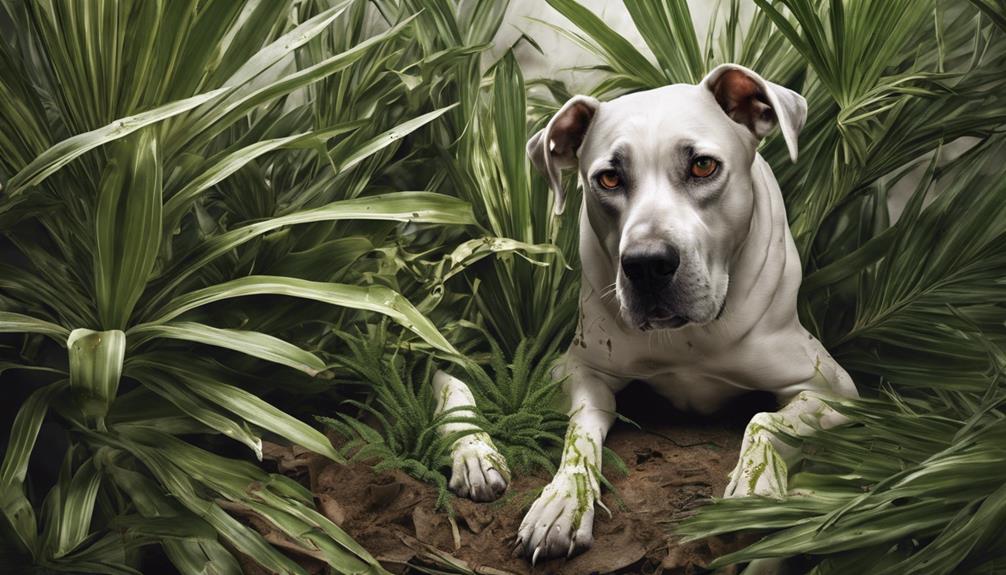
Dracaena toxicity in dogs is caused by steroidal saponins in the plant, leading to symptoms like vomiting and diarrhea. Watch for signs such as excessive drooling and weakness, indicating poisoning. Immediate veterinary care is essential to prevent long-term organ damage. Treatment involves inducing vomiting, IV fluids, and activated charcoal. Recovery varies based on toxicity levels and prompt intervention. Prevent poisoning by keeping Dracaena out of reach, and opt for non-toxic plants. Veterinarians provide post-exposure care plans for monitoring. Costs for treatment range from $200 to $1,200. Proper care is vital for recovery, as poisoning is usually not lethal. More insights await.
Key Takeaways
- Dracaena toxicity in dogs is caused by steroidal saponins.
- Symptoms include vomiting, diarrhea, weakness, and ataxia.
- Prompt veterinary care is crucial to prevent long-term damage.
- Treatment involves inducing vomiting, IV fluids, and charcoal.
- Prevention includes keeping Dracaena out of pets' reach.
Understanding Dracaena Toxicity in Dogs
We must grasp the dangers of Dracaena toxicity in dogs, primarily caused by steroidal saponins found in the plant. Dracaena, a common household plant, can pose a significant risk to our furry companions due to its toxic properties.
When dogs ingest parts of the Dracaena plant, such as the leaves or stems, they may experience symptoms like vomiting. This reaction is their way of trying to rid their bodies of the harmful substances present in the plant.
Recognizing these signs of toxicity is vital in seeking prompt veterinary care to address the issue before it escalates. Understanding the potential dangers of Dracaena toxicity and being proactive in preventing access to the plant can help safeguard our pets' well-being.
Signs of Dracaena Poisoning in Dogs
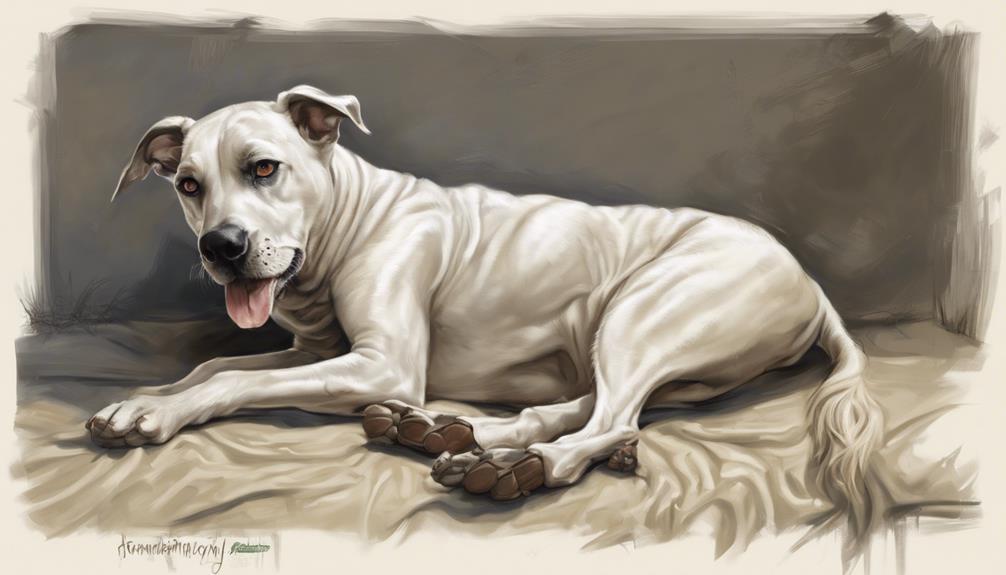
Dogs affected by Dracaena poisoning may exhibit symptoms such as vomiting, diarrhea, excessive drooling, and stomach/intestinal irritation. Anorexia, where dogs lose their appetite, can also be a sign of Dracaena toxicity. If your furry friend is feeling under the weather, you might notice weakness, depression, or ataxia, which is a lack of coordination.
Additionally, ingestion of Dracaena plants could lead to drooling, vomiting (which might contain blood), and changes in breathing sounds. In severe cases, tremors, seizures, collapse, incoordination, or dilated pupils may occur. Recognizing these signs promptly is essential. Quick identification and seeking veterinary care can prevent long-term organ damage in dogs exposed to Dracaena.
Causes of Dracaena Toxicity in Dogs
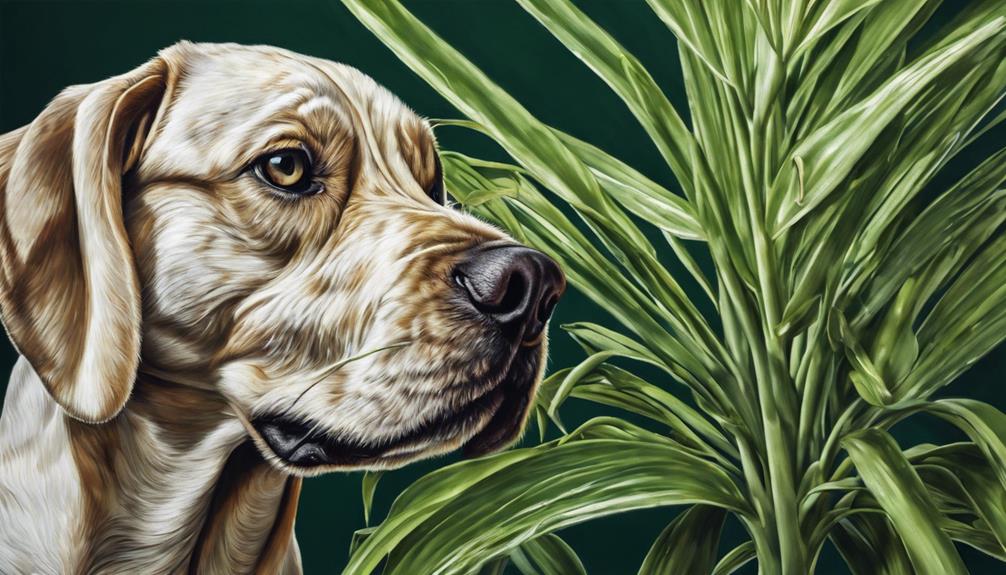
Dracaena toxicity in dogs is primarily caused by the presence of toxic compounds known as steroidal saponins in the plant. These compounds can lead to various symptoms such as gastrointestinal upset and weakness when ingested by our furry friends.
Understanding the reasons for Dracaena toxicity is essential in recognizing and addressing the potential dangers it poses to our canine companions.
Symptoms of Toxicity
Symptoms of toxicity in dogs caused by Dracaena primarily manifest as gastrointestinal issues such as vomiting, diarrhea, drooling, and stomach irritation. If your furry friend has ingested Dracaena, you might notice these signs along with ataxia, where they may seem uncoordinated or have trouble walking. Anorexia, or loss of appetite, can also occur, leading to reduced food intake.
Keep an eye out for weakness and potential blood in vomit, which could indicate a more critical reaction. If you observe any of these symptoms, seek veterinary assistance promptly. Remember, early detection and treatment are essential in managing Dracaena toxicity in dogs and preventing further complications. Your pet's well-being is our top priority!
Treatment Options
Upon encountering Dracaena toxicity in dogs, addressing the treatment options becomes imperative to alleviate the effects of the plant's toxic compounds on canine health.
Immediate treatment is essential when poisoning symptoms manifest. Veterinarians typically recommend fluid therapy to help flush out the toxins from the dog's system. This treatment aids in restoring hydration levels and promoting toxin elimination.
In severe cases, additional supportive care may be necessary to manage symptoms such as vomiting, diarrhea, and weakness. The presence of steroidal saponins in Dracaena plants necessitates prompt action to prevent further complications.
Diagnosing Dracaena Poisoning in Dogs
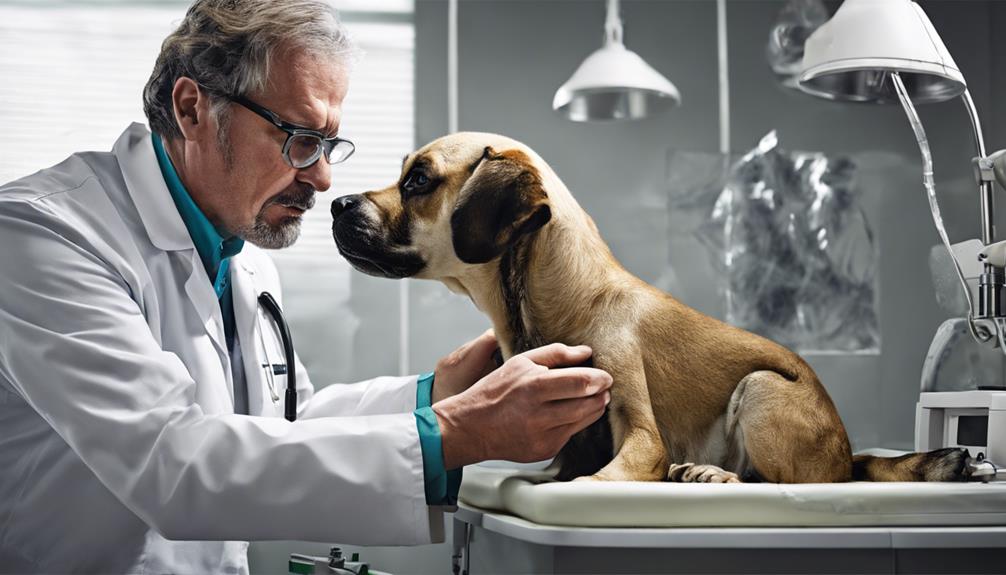
When a dog shows symptoms like vomiting, diarrhea, or weakness, a trip to the vet is essential.
The veterinarian will conduct tests like blood work and a urinalysis to assess the extent of Dracaena poisoning.
Identifying the plant your dog ingested is important for the right treatment and care.
Symptoms to Watch for
If a dog has ingested Dracaena plants, we may notice a range of signs that could indicate poisoning. These symptoms include vomiting, diarrhea, weakness, ataxia (lack of coordination), and anorexia (loss of appetite).
Observing these signs is vital as they can help in identifying if the dog has been affected by Dracaena toxicity. Additionally, dogs might display abdominal pain, depression, and overall weakness after consuming these plants.
Paying close attention to any unusual behavior or physical changes in your dog if you suspect they've ingested Dracaena is crucial. Early recognition of these symptoms can lead to prompt treatment, potentially preventing more severe consequences down the line.
Veterinary Care Needed
For diagnosing Dracaena poisoning in dogs, veterinary care is essential. A thorough physical examination by a veterinarian is the first step in the diagnosis process. This examination helps identify specific symptoms and assess the overall health of the affected dog.
Additionally, blood work, including a complete blood count (CBC) and chemistry panel, is vital for evaluating the extent of Dracaena poisoning. The CBC can provide insights into potential issues such as anemia or infection, while the chemistry panel helps assess organ function. In some cases, a packed cell volume (PCV) test may be conducted to determine dehydration levels.
Proper veterinary care, including these diagnostic measures, is necessary for effectively treating Dracaena poisoning in dogs.
Treating Dracaena Toxicity in Dogs
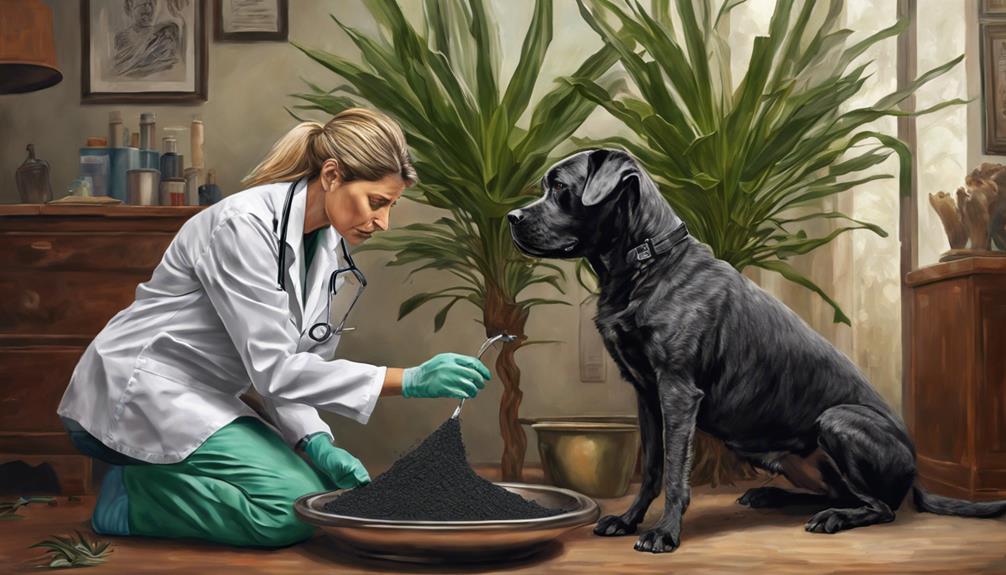
To address Dracaena toxicity in dogs, treatment often involves inducing vomiting to eliminate plant material from the system. When dealing with this issue, it's important to act swiftly and decisively.
Here are three key steps in treating Dracaena toxicity in dogs:
- Inducing Vomiting: This helps expel any remaining plant material and toxins from the stomach, preventing further absorption into the body.
- IV Fluids: Administering intravenous fluids can combat dehydration caused by vomiting and diarrhea, helping to stabilize the dog's condition.
- Activated Charcoal: This substance aids in absorbing any lingering toxins in the digestive tract, reducing their harmful effects on the body.
Recovery From Dracaena Poisoning in Dogs
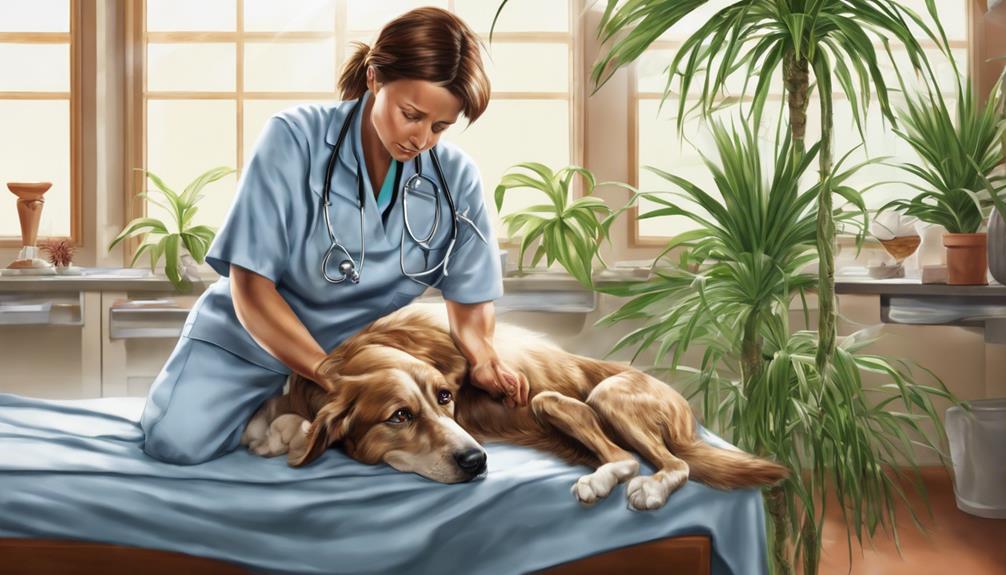
After treating Dracaena toxicity in dogs, the recuperation process is vital for guaranteeing the dog's full recovery and well-being. Recovery from Dracaena poisoning varies depending on the level of toxicity the dog was exposed to and how quickly they received prompt medical intervention.
Some dogs may bounce back with at-home supportive care, while others might need to stay at the hospital for closer monitoring and intensive treatment. Timely treatment plays a significant role in preventing long-term organ damage and complications that could arise from the poisoning.
During the recovery period, it's essential to keep a close eye on the dog's progress to ensure their well-being. Follow-up visits with the veterinarian may be necessary to assess the dog's response to treatment and make any adjustments as needed.
Veterinary Insights on Dracaena Poisoning

Veterinarians provide invaluable insights into the diagnosis and treatment of Dracaena poisoning in dogs, offering essential expertise in managing this toxic plant exposure. When it comes to dealing with Dracaena toxicity, veterinary professionals play a significant role in guaranteeing your furry friend receives the care they need to recover. Here are some essential insights from veterinarians on Dracaena poisoning:
- Symptom Management: Veterinarians are skilled at identifying and addressing symptoms like vomiting and diarrhea in dogs exposed to Dracaena. They can recommend appropriate treatments such as fluid therapy to help your pet feel better.
- Preventive Measures: Veterinary professionals can advise on preventive measures to keep your dog safe from Dracaena poisoning. Simple steps like keeping the plant out of reach and creating pet-free zones can go a long way in avoiding potential toxic exposures.
- Ongoing Veterinary Care: In cases where dogs require ongoing monitoring post-exposure, veterinarians provide tailored care plans to support their recovery. Regular check-ups and follow-up appointments can guarantee your pet's well-being in the long run.
Warneckii Dracaena Poisoning Overview

Warneckii Dracaena, a common houseplant, contains toxic saponins known to cause gastrointestinal distress and coordination issues in pets. When pets ingest parts of this plant, it can lead to poisoning, requiring immediate attention. To help you understand the impact of Warneckii Dracaena poisoning, let's explore the overview using the key points below:
| Aspect | Details |
|---|---|
| Poisoning | Warneckii Dracaena can result in toxic effects on pets. |
| Symptoms | Gastrointestinal distress, coordination issues, and weakness. |
| Treatment | Costs range from $200 to $1,200 for addressing poisoning effects. |
| Pets | Dogs and cats may experience symptoms if they ingest the plant. |
| Severity | While usually not lethal, veterinary care is essential for recovery. |
Being aware of these details can help you take quick action if your pet shows signs of Warneckii Dracaena poisoning. Remember, prompt treatment is vital to ensuring your furry friends recover swiftly from such incidents.
Symptoms of Warneckii Dracaena Poisoning

Experiencing symptoms of Warneckii Dracaena poisoning in dogs, such as abdominal pain and weakness, demands immediate veterinary attention to guarantee proper care and treatment. These symptoms can vary in severity, and it's vital to recognize them early on to make certain your pet receives the necessary care.
Here are some common signs to watch out for:
- Vomiting and GI upset: If your dog starts vomiting or showing signs of gastrointestinal distress, it could be a red flag for Warneckii Dracaena poisoning.
- Abdominal pain: Dogs experiencing abdominal pain may exhibit discomfort, restlessness, or even vocalize their distress.
- Diarrhea and excessive drooling: Keep an eye out for changes in your dog's stool consistency and an increase in drooling beyond normal levels.
Being attentive to these symptoms can help you act promptly and seek veterinary assistance to address any potential poisoning issues.
Management of Dracaena Marginata Toxicity
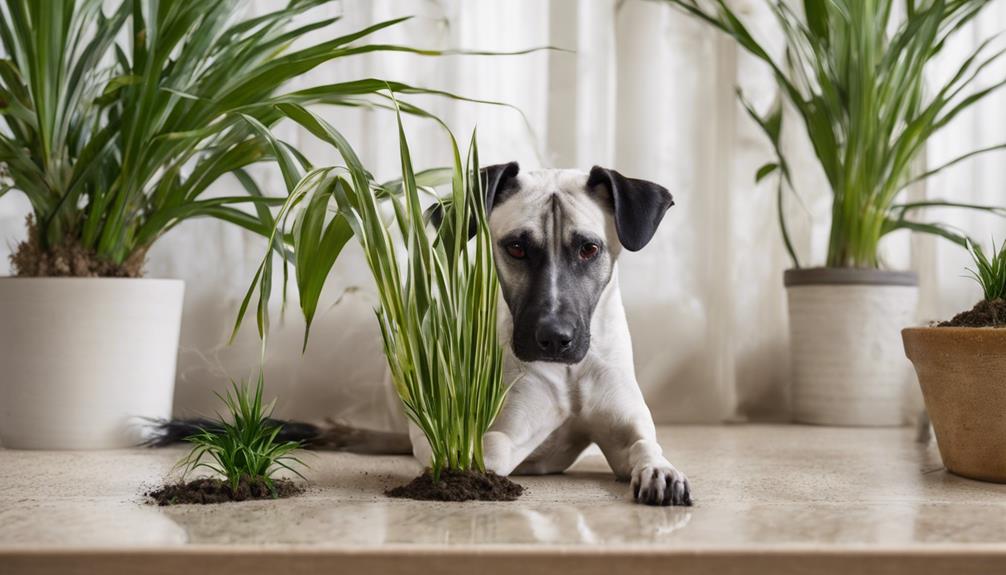
Upon encountering symptoms of Dracaena Marginata toxicity in dogs, immediate action is essential to mitigate potential health risks and guarantee proper care for the affected pet. If you suspect your dog has ingested Dracaena Marginata or come into contact with it, observe for symptoms like vomiting, diarrhea, and excessive drooling.
To manage Dracaena Marginata toxicity, start by removing any remnants of the plant from your dog's mouth to prevent further ingestion. Offer water to help clear any remaining plant bits and soothe the digestive system.
Prevention is vital to avoiding such incidents in the future. Choose non-toxic plants for your home, keep toxic plants out of reach, use physical barriers if needed, train your dog to avoid plants, and educate everyone in your household about safe plant options.
Frequently Asked Questions
How Toxic Are Dracaena to Dogs?
Dracaena plants pose a toxic risk to dogs due to steroidal saponins, causing digestive issues. Ingesting small amounts can trigger vomiting, diarrhea, weakness, and ataxia. The toxicity level varies depending on the consumed quantity and the dog's size, with small breeds and puppies at higher risk.
Immediate vet attention is essential to address Dracaena poisoning in dogs, preventing severe symptoms and ensuring a speedy recovery.
How Long Does Plant Poisoning Take in Dogs?
Plant poisoning symptoms in dogs can show up within minutes to hours after ingestion, depending on the toxin and amount consumed. Mild signs like drooling may appear quickly, while severe reactions could take longer to manifest.
Early symptoms may indicate a fast-acting toxin, while delayed ones may suggest a slower-acting poison. Monitoring for any signs of plant poisoning post-ingestion is crucial to guarantee timely veterinary care for our furry friends.
Are Red Edged Dracaena Toxic to Pets?
Yes, red edged Dracaena plants are toxic to pets, including dogs. Ingesting these plants can cause symptoms like vomiting, diarrhea, and drooling in our furry friends.
If a dog comes into contact with or consumes red edged Dracaena, they may experience gastrointestinal distress and discomfort.
It's important to seek immediate veterinary care if your dog ingests this plant to prevent serious health complications.
Is Song of India Toxic to Dogs?
Yes, Song of India, also known as Dracaena reflexa, is toxic to dogs if consumed. Symptoms like vomiting, diarrhea, and drooling can occur due to harmful compounds like saponins in the plant. Immediate veterinary care is vital if ingestion happens to prevent severe symptoms.
Keeping Song of India out of reach of pets is necessary to avoid toxicity risks.
Conclusion
To wrap up, it's crucial to keep your furry companions safe from the dangers of Dracaena toxicity. Remember to keep these plants out of reach and seek immediate veterinary care if you suspect poisoning.
It's better to be safe than sorry when it comes to the health and well-being of your beloved pets. Stay informed and proactive in preventing potential hazards in your home.
Your four-legged friends will thank you for it!
Dana is our Lead Content Writer, bringing a wealth of knowledge and expertise to our team. With a background deeply rooted in animal studies and a profound love for all creatures, Dana is dedicated to crafting engaging and informative content that resonates with our audience. With Dana at the helm, you can trust that our content is accurate and engaging, catering to the diverse interests of animal enthusiasts everywhere.
Dogs
Coolest Dog Names for Your Pup
Discover the coolest dog names for your pup that start with the letter 'O' and add a touch of individuality and charm to your furry friend's identity.

When selecting the coolest dog names for your pup, consider these categories: Unique names capture individuality; Classic names offer timeless charm; Trendy names add flair; Creative names reflect personality; Celebrity-inspired names bring glamour; Nature-inspired names connect with the outdoors; Humorous names add delight. Each category offers options to make your furry friend stand out and reflect your style. Whether you lean towards uniqueness, tradition, trendiness, creativity, glamour, nature, or humor, there's a perfect name waiting for your pup. Your furry companion's identity is a reflection of your bond and shared adventures.
Key Takeaways
- Choose unique names inspired by nature, literature, or history for individuality.
- Opt for trendy names like Sawyer, Bella, or Quinn for a stylish touch.
- Consider classic names for timeless charm and easy recall.
- Get creative with names reflecting your dog's personality or your interests.
- Infuse humor with quirky names to spark conversations and add fun to everyday interactions.
Unique Dog Names for Standout Pups
When naming your furry companion, opt for distinctive titles that capture their unique essence and charm. Unique dog names provide a special touch, setting your pup apart from the rest.
Drawing inspiration from nature, literature, theater, film, or history can help you find the perfect fit for your beloved pet. These uncommon options celebrate your dog's individuality and personality, making them stand out from the pack in a crowd.
Whether you have a tiny Chihuahua or a majestic Great Dane, there are unique names suitable for dogs of all sizes and breeds. By choosing a unique dog name, your pup can make a statement and be easily recognized wherever you go.
Embrace the opportunity to showcase your furry friend's distinctive qualities with a name that reflects their special character. Let your pup shine with a one-of-a-kind name that truly suits them.
Classic Dog Names With Timeless Appeal

Let's explore classic dog names that exude timeless charm and appeal for your beloved furry companion. When it comes to boy dog names, classics like Max, Buddy, and Charlie stand the test of time. These names have been favorites among pet owners for decades, offering a sense of familiarity and tradition. Classic dog names aren't only easy to remember and pronounce, but they also have a universal charm that suits dogs of all breeds and sizes.
Choosing a classic dog name can evoke a sense of nostalgia and provide your pup with a connection to other beloved pets throughout history. These names carry a certain heritage that can make your furry friend feel like a part of something special. So, if you're looking for a timeless and comforting choice for your new pet, consider one of these classic dog names for a touch of enduring appeal.
Trendy Dog Names for Fashionable Fidos
Exploring the latest trends in dog names for fashionable fidos reveals a plethora of stylish options to suit your trendy pup's personality. For male dogs, names like Sawyer, Jack, Hudson, Finn, and Emerson are at the top of the trend charts. These names exude a sense of sophistication and charm, perfect for the dapper canine companion by your side.
On the other paw, female dogs are strutting their stuff with names like Elsa, Bella, Stella, Quinn, and Sophie, showcasing elegance and flair in every bark and tail wag.
In 2015, the scene was different with names like Tucker, Bear, Duke, Toby, and Rocky leading the pack for male dogs, while Bailey, Chloe, Sophie, Maggie, and Sadie dominated for females. When naming your dog, it's crucial to choose a name that's short, sweet, and reflects your pet's character. Avoid names that sound like commands to guarantee clear communication with your furry friend. Choose a trendy name that will have heads turning when you and your fashionable fido strut down the street.
Creative Dog Names to Show Off

To make your furry friend stand out in the dog park, contemplate selecting a creative name that mirrors their unique personality and sparks conversations with other pet owners. Creative dog names can be influenced by a variety of sources, such as favorite foods, hobbies, or even the distinctive characteristics of your beloved pup.
When choosing a creative dog name, reflect on how it resonates with your own personality and style as a pet owner. These unique names not only distinguish your dog but also have the ability to initiate engaging conversations and create memorable interactions with fellow dog enthusiasts.
It's crucial to take into account factors like the sound, length, and ease of pronunciation of the chosen name for everyday use. By opting for a creative dog name, you aren't only showcasing your pup's individuality but also adding a touch of flair to your pet parenting journey.
Celebrity-Inspired Dog Names for Star Pooches
When considering celebrity-inspired dog names for your furry companion, you can infuse a touch of glamour and uniqueness to their identity. Names like 'Beyonce,' 'Kanye,' or 'Oprah' not only pay homage to your favorite celebrities but also add a cool factor to your dog's persona. These names serve as fun conversation starters and showcase your love for pop culture, making your pup stand out at the dog park.
Whether you admire a famous actor, musician, or athlete, the options are endless for your star pooch. Embracing a celebrity-inspired dog name allows your pet to carry a piece of the limelight wherever they go, embodying a sense of charisma and style that reflects your appreciation for iconic figures.
Nature-Inspired Dog Names for Outdoor Lovers

Nature-inspired dog names offer a way to connect with the natural world through your furry friend's moniker. Forest-themed names like Oak, Birch, or Fern can evoke images of dense woodlands and tranquility.
Water-inspired names such as Brook, Wave, or Coral bring to mind the calming presence of rivers, oceans, and marine life.
Forest-Themed Dog Names
Exploring forest-themed dog names offers outdoor enthusiasts a delightful way to connect their furry companions to the natural world. These names, such as Oakley, Willow, Cedar, Aspen, and Birch, not only evoke the serene and majestic qualities of the forest but also bring a sense of adventure and exploration to your pup's identity.
Choosing a forest-themed name for your dog can create a unique bond with nature, showcasing your love for the outdoors while honoring your dog's adventurous spirit. It's a conversation starter and adds a touch of whimsy and charm to your dog's persona.
Embracing these nature-inspired names can enhance your outdoor experiences and deepen the connection between you and your four-legged friend.
Water-Inspired Dog Names
Linking our furry companions to the elements of nature, water-inspired dog names provide a rejuvenating and significant way to honor their adventurous spirit. These names, such as River, Bay, Cove, Marina, and Sailor, can reflect your love for the outdoors and nature while adding a touch of uniqueness to your pup's identity.
For dogs who enjoy water activities or have a special connection to the ocean, water-themed names evoke a sense of tranquility and adventure. Choosing a water-inspired name can't only be meaningful but also a fun way to showcase your pup's love for the great outdoors.
Mountain-Related Dog Names
Embracing the rugged spirit of the great outdoors, mountain-related dog names embody a sense of adventure and strength that resonates with nature-loving pet owners.
- Aspen: Reflecting the beauty of the quaking aspen trees that dot mountain landscapes.
- Everest: Evoke the grandeur and challenge of the world's highest peak.
- Sierra: Pay homage to the majestic Sierra Nevada mountain range.
- Summit: Symbolize reaching the pinnacle, just like conquering a mountain top.
- Alpine: Capture the essence of high-altitude regions and alpine meadows.
These names can infuse your furry friend with the majesty of nature, symbolizing resilience, exploration, and a shared love for the great outdoors.
Funny Dog Names to Bring Joy

Funny dog names can bring cheer and playfulness to our lives, making each day a little brighter. These clever monikers showcase our wit and originality, adding a fun twist to our furry companions.
From punny wordplays to hilarious pop culture references, funny dog names are sure to elicit smiles and create lasting memories.
Witty Name Ideas
With a dash of creativity and a sprinkle of humor, selecting a witty name for your dog can add an extra layer of joy to your furry companion's character. Here are some funny dog names that are sure to bring a smile to your face:
- Bark Twain
- Chewbacca
- Mary Puppins
- Sir Barksalot
- Princess Paws
These names for female dogs aren't only amusing but also reflect the quirky traits and characteristics of your beloved pet. Choosing a witty dog name can showcase your sense of humor and creativity, making everyday interactions with your pup more enjoyable and entertaining.
Humorous Naming Tips
Let's explore how incorporating humor into your dog's name selection can add a delightful touch to your furry friend's identity. When naming your boy or girl dog, consider puns, wordplay, pop culture references, or quirky traits for a funny twist.
From naming your pup after favorite foods to famous characters or choosing ironic names, the possibilities are endless. Opting for a humorous dog name showcases your creativity and sense of humor, setting your dog apart with a unique identity.
Picture the joy a funny name can bring as you call out to your pet in the park. It's a fun way to spark conversations and make lasting memories with your funny-named furry companion.
Frequently Asked Questions
What Are Unique Names for a Puppy?
We explore unique names for a puppy that reflect individuality and are easy to pronounce. Consider options like Amabel, Ismay, or Benno for a distinct and memorable choice. Choose a name both you and your pup will love!
What Is the Coolest Dog Name Ever?
We believe the coolest dog name ever is Maverick. It exudes a sense of adventure and independence while being easy to pronounce. Naming your pup should be a reflection of your style and their personality.
What Are Rare Pet Names?
Rare pet names are unique selections that set pets apart. They're not commonly used, adding a special touch to your furry friend's identity. These names can be inspired by various sources, sparking conversations and intrigue.
What Are Exotic Names for Dogs?
Exotic dog names, like Azura and Kairo, add a touch of mystery. Drawing from various cultures, they reflect our interests and make a lasting impression. Choosing one can be a fun way to showcase creativity.
Conclusion
To sum up, selecting the ideal name for your pup can be an enjoyable and thrilling process. Did you know that based on a recent study, more than 50% of pet owners opt for distinctive or imaginative names for their dogs?
Whether you lean towards timeless, fashionable, or amusing names, there are numerous choices to complement your furry companion's character. By tapping into a bit of ingenuity and motivation, you can discover a name that perfectly aligns with your pup's distinct charm.
As our Editor-in-Chief, James plays a pivotal role in ensuring the quality and integrity of our content. With a keen eye for detail and a passion for storytelling, James oversees the editorial process here at A Place for Animals. With years of experience in content editing, James ensures that every piece of content meets our high standards of accuracy and clarity. Under James’ guidance, you can rest assured that the content you read is informative and impeccably crafted.
Dogs
Safely Feeding Dogs Popcorn: A Guide for Pups

When feeding dogs popcorn, stick to plain, air-popped kernels. Avoid butter, salt, or sugar. Treat it as a small snack. Watch out for choking hazards like unpopped pieces. A balanced diet with safe popcorn makes for happy pups. Remember, with the right precautions, popcorn can be a tasty treat for your furry friend.
Key Takeaways
- Choose plain, air-popped popcorn for dogs.
- Avoid additives like butter, salt, or sugar.
- Monitor popcorn intake to prevent digestive issues.
- Watch for choking hazards like unpopped kernels.
- Consult a vet for personalized advice, especially for dogs with health conditions.
Popcorn Safety for Dogs
When it comes to feeding dogs popcorn, it's crucial to stick to plain, air-popped varieties without any added toppings. Popcorn can be a tasty treat for our furry friends, but we need to be mindful of their safety. Giving dogs popcorn with butter, salt, sugar, or caramel is a no-go. These toppings can upset their stomachs and lead to health issues.
Remember, treats should only make up a small portion of a dog's daily calorie intake, so popcorn should be an occasional indulgence, not a regular snack. Those unpopped kernels at the bottom of the bowl may seem harmless to us, but they can pose a choking hazard for dogs. Always be cautious and remove any kernels before sharing popcorn with your pup.
Keeping their diet balanced and free from harmful toppings guarantees that your dog can enjoy a safe and delicious popcorn treat.
Choosing the Right Popcorn for Dogs

Choosing plain, air-popped popcorn for your furry friend guarantees a safe and enjoyable treat without any harmful additives. When selecting popcorn for your dog, keep these tips in mind:
- Opt for Plain: Stick to plain, air-popped popcorn without any added seasonings like butter, salt, sugar, cheese, or caramel. These additives can be harmful to your dog's health.
- Fully Popped Kernels: Make sure that all popcorn kernels are fully popped to reduce the risk of a choking hazard for your dog. Unpopped kernels can pose a danger, so checking before sharing with your pup is crucial.
- Monitor Intake: Keep an eye on how much popcorn your dog eats. While popcorn can be a tasty snack, overconsumption can lead to potential digestive issues. Moderation is key to keeping your pup happy and healthy.
- Consult Your Veterinarian: If you have any concerns about feeding popcorn to your dog or if your dog has specific health conditions, always consult with your veterinarian for personalized advice. Your vet can provide guidance tailored to your dog's individual needs.
Benefits of Popcorn for Pups

To understand why popcorn can be beneficial for pups, it's important to recognize the small amounts of B vitamins present in this snack that contribute to their overall health and well-being. Dogs can eat popcorn as an occasional treat, as the nutritional benefits of vitamins like riboflavin and thiamine aid in digestion, vision, and energy levels.
When feeding popcorn to your furry friend, opt for plain, air-popped popcorn without harmful toppings for a vital snacking option. It's essential to monitor your dog for any negative reactions such as vomiting or diarrhea, ensuring that their intake is in moderation.
Monitoring Popcorn Intake for Dogs

When it comes to dogs and popcorn, it's important to monitor their intake closely. Keeping an eye on how much popcorn your furry friend is having can help prevent overeating issues.
Additionally, watching out for any stray kernels that could pose a choking hazard is essential for your pet's safety.
Portion Control Importance
Observing the amount of popcorn your dog consumes is vital for their digestive health and weight management. When it comes to feeding dogs popcorn, portion control is key to preventing overconsumption and potential issues like digestive upset and weight gain. To keep your pup healthy and happy, remember these essential points:
- Limit Intake: Dogs should only have popcorn as an occasional treat.
- Monitor Calories: Popcorn should make up 10% or less of your dog's daily caloric intake.
- Small Amounts: Offer popcorn in small portions to avoid overfeeding.
- Overall Health: Regularly monitoring your dog's popcorn intake can help maintain their overall health and well-being.
Watch for Choking Hazards
Keeping an eye on your dog's popcorn intake is important for preventing choking hazards. Dogs eat popcorn with enthusiasm, but it's vital to remove unpopped kernels and monitor their intake.
Feeding large quantities of popcorn can increase choking risks, so it's essential to supervise your pup while they enjoy this treat. Be cautious and watch for any signs of distress or choking while your dog eats popcorn.
Potential Risks of Feeding Popcorn

Feeding popcorn to dogs can pose various risks to their health and well-being. When considering giving your furry friend this snack, it's important to be aware of the potential dangers they might face:
- Choking Hazard: Dogs may have difficulty chewing popcorn, especially unpopped kernels, which can lead to choking incidents.
- Intestinal Upset: Buttered or seasoned varieties of popcorn can upset your dog's stomach, causing digestive issues.
- Obesity: Excessive consumption of popcorn can contribute to obesity in dogs, leading to various health problems.
- Added Toppings: Popcorn with added toppings like salt, sugar, or caramel should be avoided as these can be harmful to your dog's health.
To keep your pup safe, opt for plain popcorn and monitor them closely for any negative reactions after eating. By being mindful of these risks, you can make sure that your dog enjoys their popcorn treat without putting their health in jeopardy.
Tips for Feeding Popcorn to Dogs

When considering offering popcorn to your dog, it's crucial to be mindful of a few key tips to guarantee their safety and enjoyment. Popped corn is generally okay for dogs to eat in small amounts as an occasional treat. Make sure you only feed them plain, air-popped popcorn without any added toppings like butter, salt, or sugar.
Remove any partially popped kernels from the batch before feeding it to your furry friend to prevent choking hazards. Bear in mind that popcorn should make up no more than 10% of your dog's daily calorie intake to maintain a balanced diet. It's also good to be conscious of potential corn allergies in dogs before introducing popcorn to them.
Keep these healthy feeding guidelines in mind to ensure your pup stays happy and healthy when enjoying a snack.
Recognizing Negative Reactions in Dogs

We must be vigilant for any signs of negative reactions in dogs following the consumption of popcorn, such as vomiting or diarrhea. When monitoring your furry friend, keep an eye out for any unusual behavior that could indicate a negative response to the popcorn. Be aware of choking hazards and potential dental issues that may arise from feeding your dog this snack. In case your dog ingests a large quantity of buttered popcorn, it's essential to contact your veterinarian promptly to safeguard their health and well-being.
- Watch for signs of negative reactions: Keep an eye out for vomiting or diarrhea after your dog eats popcorn.
- Monitor behavior closely: Look for any unusual behavior or discomfort that could signal a negative response to the snack.
- Beware of choking hazards: Be cautious of potential choking hazards that popcorn may present to your dog.
- Contact your veterinarian: Seek professional advice if your dog consumes a large amount of buttered popcorn to protect their health.
Popcorn-Inspired Dog Treats and Toys

To introduce some excitement and engagement into your dog's playtime and enrichment routine, consider incorporating popcorn-themed chew toys and treats.
Popcorn-inspired toys and treats can provide mental stimulation and satisfy your dog's chewing instincts. Look for safe and durable popcorn-themed toys that are suitable for your dog's size and play style.
A popcorn-flavored chew treat can be a tasty snack for your furry friend, offering a delicious reward during playtime. These treats may come in various forms, such as pieces or even partially popped kernels, adding a fun twist to your dog's snack time.
A popcorn-themed chew toy can mimic the enjoyment of popcorn without the risks associated with actual popcorn consumption. By introducing popcorn-inspired toys and treats, you can add variety to your dog's playtime and enrichment activities, keeping them entertained and engaged.
Remember to always supervise your dog while they enjoy their popcorn-flavored chew treat or popcorn-themed toy to guarantee a safe and enjoyable experience.
Frequently Asked Questions
Is Popcorn Safe for Puppies?
Popcorn can be safe for puppies if plain and air-popped. It should be free of salt, butter, or any other toppings.
Remember, treats like popcorn should only be a small part of a puppy's daily diet. Watch closely for any negative reactions when introducing new foods.
Moderation is key when giving puppies popcorn as a snack.
What Happens if a Puppy Eats a Piece of Popcorn?
If a puppy eats a piece of popcorn, it's unlikely to cause harm. Popcorn isn't toxic to puppies in small amounts.
Puppies may find popcorn appealing due to its texture and smell. Monitor your puppy for any signs of choking or digestive issues after eating popcorn.
Always confirm that popcorn given to puppies is plain and unsalted to avoid potential health risks.
Can Puppies Eat Sweet and Salty Popcorn?
Yes, puppies shouldn't eat sweet or salty popcorn. The high sugar in sweet popcorn can cause digestive issues, while excessive salt in salty popcorn may lead to dehydration in pups.
Stick with plain, unsalted popcorn for your furry friend's safety. Always supervise your puppy closely when introducing any new food, including popcorn, to guarantee their well-being. Remember, their delicate digestive systems require us to be careful with their diet choices.
Why Is My Dog Throwing up After Eating Popcorn?
When dogs vomit after eating popcorn, it could be due to the high fat content, seasonings like salt, or potential corn allergies.
Eating too much popcorn at once may overwhelm a dog's tummy. If your furry friend keeps tossing their treats, it's wise to seek advice from a vet.
Conclusion
To sum up, when it comes to safely feeding your furry friend popcorn, it's crucial to select the right type, monitor their intake, and watch for any negative reactions. Remember, 'all that glitters isn't gold,' so always prioritize your pup's well-being.
With proper care and attention, you can enjoy sharing this tasty treat with your dog while keeping them healthy and happy. Stay informed and proactive to guarantee your pup's popcorn experience is a positive one.
Dana is our Lead Content Writer, bringing a wealth of knowledge and expertise to our team. With a background deeply rooted in animal studies and a profound love for all creatures, Dana is dedicated to crafting engaging and informative content that resonates with our audience. With Dana at the helm, you can trust that our content is accurate and engaging, catering to the diverse interests of animal enthusiasts everywhere.
Dogs
The Origins of Ebons Name
Nurture your curiosity about the enigmatic origins and powerful connotations of the name 'Ebon.

The name 'Ebon' originates in Old English, tied to ebony wood in the 15th century. It transformed to represent intense blackness by the 1590s. Latin influences give it power, elegance, and mystery, creating a name of grandeur and timelessness. In various cultures, 'Ebon' signifies strength, mystery, elegance, power, and authority. Variants like Ebony and Ebenezer hold biblical meaning. The name also connotes resilience, intelligence, history, and tradition, appealing universally with enduring qualities. The historical significance of 'Ebon' includes references to ebony wood and intense blackness, symbolizing resilience, determination, and mystery. More insights await on this fascinating name's journey.
Key Takeaways
- 'Ebon' originated from Old English in early 15th century.
- Initially tied to the adjective form of ebony.
- Evolved to symbolize intense blackness by 1590s.
- Latin and Greek roots imbue 'Ebon' with power and elegance.
- Historical reference to skin color of Africans by 1813.
The Old English Origins of 'Ebon'
The term 'Ebon' reveals its roots in Old English, tracing back to the early 15th century. Originally associated with the adjective form of ebony, a dark and hard wood highly valued for its various uses, 'Ebon' has evolved to symbolize intense blackness, a concept noted as early as the 1590s.
In the context of last names, 'Ebon' has historical ties to the color black, reflecting the rich tapestry of its linguistic journey. The adoption of 'Ebon' as a last name signifies a connection to heritage and a nod to the deep and profound shades of black that have inspired awe and admiration for centuries.
As we explore the origins of 'Ebon,' we expose a narrative that intertwines linguistic evolution with cultural connotations, offering a glimpse into the intricate web of meanings encapsulated by this ancient term.
The Latin Influence on 'Ebon'

With its roots deeply intertwined in Latin and Greek languages, 'Ebon' exudes a timeless allure that echoes notions of strength, elegance, and mystery. The Latin influence on 'Ebon' is profound, reflecting its association with power and authority. The name's Latin origins highlight its classic appeal and deep historical significance, adding a layer of sophistication to its meaning. Below is a table showcasing the Latin influence on 'Ebon':
| Latin Influence | Meaning | Symbolism |
|---|---|---|
| Potestas | Power | Authority |
| Elegans | Elegance | Sophistication |
| Mysterium | Mystery | Intrigue |
| Fortitudo | Strength | Resilience |
| Auctoritas | Authority | Leadership |
The Latin roots of 'Ebon' infuse the name with a sense of grandeur and timelessness, making it a compelling choice rich in cultural significance.
The Meaning of 'Ebon' in Different Cultures
Exploring the significance of 'Ebon' across various cultures reveals its multifaceted meanings and associations beyond its Latin roots. In Latin and Greek cultures, the name 'Ebon' carries the powerful connotations of 'black' or 'dark,' symbolizing strength and mystery. This name is deeply intertwined with resilience and intelligence, embodying a profound connection to history and tradition.
Across different cultures, 'Ebon' is synonymous with elegance, power, and authority, drawing from its ancient Roman and Greek origins. Its timeless and classic appeal speaks to sophistication and depth, making it a name of enduring quality. Variants such as Ebony, Eben, and Ebenezer also bear historical and biblical significance, offering unique twists on the name 'Ebon.'
These names hold a rich tapestry of meanings that transcend borders, showcasing the universal allure of 'Ebon' and its variations in the world of names.
Historical Significance of the Name 'Ebon'

Delving into the historical significance of the name 'Ebon' uncovers a rich tapestry of connections to materials, cultures, and symbolism.
- Baby Name Associations:
The name 'Ebon' originated in the early 15th century and is linked to ebony, a dark, hard wood favored for various uses. Its figurative use for intense blackness dates back to the 1620s, with an adjective form emerging in the 1590s.
- Material Connotations:
The term 'Ebonite,' coined in 1860, combines 'ebon' and '-ite' to signify a related material or substance, emphasizing its historical ties to strength and durability.
- Cultural References:
By 1813, 'Ebon' had a historical reference to the skin color of Africans, reflecting its association with darkness and intensity while also symbolizing elegance and mystery rooted in ancient Roman and Greek cultures.
- Symbolism of Resilience:
The name 'Ebon' signifies resilience and determination, echoing themes of strength and mystery in various historical contexts, making it a meaningful choice for parents seeking a name with depth and significance.
Evolution of the 'Ebon' Surname
The surname 'Ebon' underwent a transformation over the centuries, reflecting its deep-rooted connection to the symbolism of dark, hard wood. Originating in the early 15th century, 'Ebon' derived from the word 'ebony,' signifying the characteristics of this material. By the 1620s, it had evolved to convey intense blackness, capturing the essence of ebony. The term 'Ebonite,' introduced in 1860, further expanded on this association, referring to a related material or substance akin to ebony.
Through the years, 'Ebon' became intertwined with concepts of skin color and holds a historical tie to African heritage. This evolution mirrors the shifting societal perceptions and associations with darkness and blackness. The popularity of names often reflects these underlying cultural currents, showcasing how 'Ebon' has adapted and resonated with different generations.
Frequently Asked Questions
What Is the Meaning of Ebons?
Ebons means 'black' or 'dark', embodying strength, elegance, and mystery. It reflects resilience and determination from ancient Roman and Greek roots. Intelligence, intuition, and a timeless appeal are qualities associated with it.
What Does Ebon Name Mean?
We love the name Ebon. It means 'black' or 'dark', representing strength, elegance, and mystery. A timeless choice that exudes power and authority. Ebon's rarity and modern edge make it a unique and compelling name.
What Is the Origin of the Word Ebon?
We found the word "ebon" originates from Latin and Greek roots, symbolizing strength, elegance, mystery, power, and authority. It evolved to describe intense blackness. The term was used for various items and associated with African skin color.
What Does "Ebon" Mean in Greek?
In Greek, 'Ebon' means 'dark' or 'black,' embodying qualities of strength, elegance, and mystery. Its association with intensity and depth adds a timeless appeal. The name symbolizes power, authority, and sophistication.
Conclusion
To sum up, the origins of the name 'Ebon' are as mysterious and complex as the darkness it represents. From Old English roots to Latin influences, the name has evolved over time to carry different meanings in various cultures.
Its historical significance and evolution as a surname add layers to its intriguing story. So next time you come across someone named Ebon, remember the rich history behind this enigmatic name. It's more than just a label, it's a window into the past.
As our Editor-in-Chief, James plays a pivotal role in ensuring the quality and integrity of our content. With a keen eye for detail and a passion for storytelling, James oversees the editorial process here at A Place for Animals. With years of experience in content editing, James ensures that every piece of content meets our high standards of accuracy and clarity. Under James’ guidance, you can rest assured that the content you read is informative and impeccably crafted.
-

 Vetted2 months ago
Vetted2 months ago15 Best Cat Foods for Managing Hyperthyroidism – Vet Approved and Feline Friendly
-
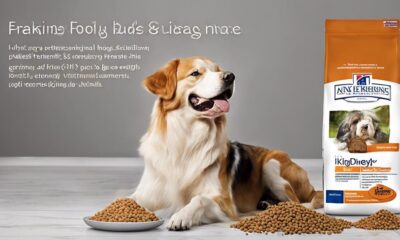
 Vetted2 months ago
Vetted2 months ago15 Best Dog Foods for Kidney Disease – Expert Recommendations for Your Pet's Health
-

 Vetted2 months ago
Vetted2 months ago15 Best Wet Cat Foods for Older Cats to Keep Them Healthy and Happy
-

 Vetted2 months ago
Vetted2 months ago14 Best Homemade Dog Food Recipes Your Pup Will Love – Vet Approved & Nutritious
-

 Vetted2 months ago
Vetted2 months ago15 Best Fresh Dog Food Delivery Services for Your Pup's Health and Happiness
-

 Animal Facts2 months ago
Animal Facts2 months agoSpring Animals: A Guide to Seasonal Wildlife
-

 Cats2 months ago
Cats2 months agoCat Weight Chart by Age: Kitten to Senior in Lbs
-

 Cats2 weeks ago
Cats2 weeks agoTop 5 Cat Breeders in Arkansas: A Guide





















